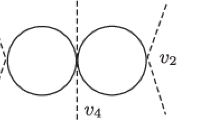Summary
We recover the general form of the one-loop effective potential for aλφ 4 theory, nonminimally coupled to a constant-curvature background geometry, in the low-energy limit,i.e. for small curvature. Renormalization is carried out and the massless limit of the renormalized theory is performed. Then we study the symmetry properties of the vacuum state according to the value of the nonminimal coupling constant ξ and the sign of the curvature.
Riassunto
Si ricava la forma generale del potenziale effettivo ad un cappio per una teoriaλφ 4, accoppiata non minimalmente ad una geometria di fondo a curvatura costante, nel limite di bassa energia,i.e. per piccola curvatura. Una volta rinormalizzata la teoria, se ne considera il limite di massa nulla. Quindi si studiano le proprietà di simmetria dello stato di vuoto a seconda dei valori della costante di accoppiamento non minimale e del segno della curvatura.
Резюме
Мы выводим общее выражение для одно-петельного эффективного потенциала для λϕ4 теории, не минимально связанной с геометрией фона с постоянной кривизной в пределе низких энергий, т.е. для малой кривизны. Проводится перенормировка и рассматривается безмассовой предел перенормированной теории. Затем мы исследуем свойства симметрии состояния вакуума, в зависимости от значения не минимальной постоянной связи ^ и знака кривизны.
Similar content being viewed by others
References
T. W. Kibble:Phys. Rep.,67, 183 (1980), and reference therein.
L. F. Abbott: CERN preprint TH 3018 (1981).
S. W. Hawking: inGeneral Relativity, an Einstein Centenary Survey, edited byW. Israel (Cambridge, Mass., 1980).
S. W. Hawking:Commun. Math. Phys.,55, 193 (1977).
B. S. De Witt:Phys. Rep. C,19, 295 (1975).
G. Denardo andE. Spallucci:Nuovo Cimento A,69, 151 (1982).
S.L. Adler:P7m/s. Rev. Lett.,44, 1567(1980);A. Zee:Phys. Rev.D,23, 858 (1981);D. Amati andG. Veneziano: CERN preprint TH 3126 (1981).
P. B. Gilkey:J. Diff. Gemo.,10, 601 (1975).
S. Coleman andE. Weinberg:Phys. Rev. D,7, 1888 (1973).
This feature is also exhibited, in a different context, by the calculations ofD. J. Toms:Phys. Rev. D,21, 2805 (1980).
G. Kennedy:Phys. Rev. D,23, 2884 (1981);G. Denabdo andE. Spallucci:Nuovo Gimento, A,68, 177 (1982).
Dynamical symmetry breaking induced by a nonminimal coupling has been recently discussed byG. Denardo andE. Spallucci:Lett. Nuovo Cimento,33, 336 (1982);L. H. Ford andD. J. Toms: ICTP/81: 81–82.
Author information
Authors and Affiliations
Rights and permissions
About this article
Cite this article
Denardo, G., Spallucci, E. Curvature and symmetry breaking: An induced-action approach. Nuov Cim A 71, 397–408 (1982). https://doi.org/10.1007/BF02898934
Received:
Published:
Issue Date:
DOI: https://doi.org/10.1007/BF02898934



